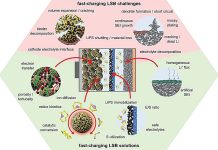
When we think of the future, flying cars, and robots might come to mind.
But engineers at the University of California San Diego are working on something different.
They’re crafting materials that not only give shape and support to objects like boats and phones but also store energy to power them.
This sounds like science fiction, but it’s real and happening now.
Bridging Strength and Energy: A Dual-Purpose Material
Imagine a phone case that’s not just there to protect your phone but also holds extra power to keep it charged. Or consider an electric car where the doors themselves help power the vehicle.
This is what researchers are trying to make possible. Usually, materials are either good at being strong or storing energy – doing both was a challenge.
The recent development from the University of California San Diego, however, is finding a way to merge these two aspects beautifully.
To understand this better, let’s peek into a simple demonstration they did.
Researchers made a tiny boat using their special material which not only formed the structure (or body) of the boat but also stored energy from sunlight to power a small motor, making the boat move. So, the boat’s structure wasn’t just a shell; it was an energy storage unit too.
Weaving Carbon and Polymers: The Craft Behind the Magic
How does this special material work? In simple words, it’s made by weaving together carbon fibers, which are very strong, and then coating them with a mixture that’s good at storing and moving electrical energy.
The second crucial part is a solid substance that both helps in holding everything strongly together and allows electrically charged particles to move about easily, which is vital for storing and using energy.
To give a comparison, imagine a sponge (which has many holes and lets water flow through easily) that is also as strong as steel. This is a basic way to think about how this material works.
The material has regions that allow electric charges to move freely (like the sponge letting water through) and regions that provide strength and structure (like the steel).
A Stepping Stone to a Future of Efficient Energy Use
While it’s quite an advancement, researchers admit that there’s a lot more to be done to enhance this technology.
These new materials, which are like supercharged sponges, currently can release a burst of energy very quickly but can’t hold as much energy as some batteries can.
The scientists are now focused on finding ways to increase the amount of energy these materials can store, so they can be used in practical, everyday applications, like powering our phones or cars.
This is a fascinating step into a future where every bit of an object could serve multiple purposes – providing shape, strength, and also storing energy.
Imagine the possibilities! Your laptop case could provide extra hours of charge, the walls of your house might store solar energy, or the frame of your e-bike could give you that extra mile of power when your battery runs low.
In the vast ocean of technological advancements, this research is a beacon guiding us towards a future where our structures are not just inert shells but active, energy-storing entities contributing to a greener and more efficient world.
The implications are vast and while the researchers continue to refine and enhance this technology, we wait with bated breath for a future where our very structures power our endeavors.
The road ahead is one of refinement and discovery, with this research acting as a crucial stepping stone towards an innovative future where our technologies are not just used but are an integral part of our power solutions.
So, while robots and flying cars are amazing, these self-powering structures might just steal the show in the future that lies ahead.
The research findings can be found in Science Advances.
Follow us on Twitter for more articles about this topic.



